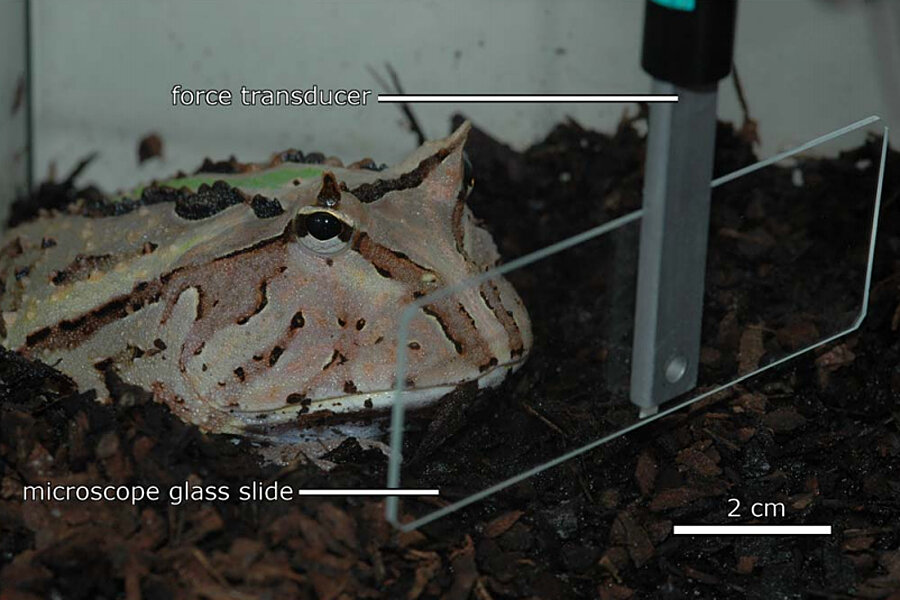Frogs' tongues could be much stickier than thought, say scientists
Loading...
Imagine pulling a 400-lb. object into your mouth using just your tongue.
Chances are, you can’t. The current Guinness World Record holder, Englishman Thomas Blackthorne, can lift just over 27 pounds.
Yet that's pretty much what the horned frog does to ensnare its largest meals, according to a new study conducted at Christian-Albrechts-Universität-Kiel in Kiel, Germany.
The amphibian’s muscular tongue sticks to its prey much like Scotch tape does, but with a force strong enough to capture something three times its body weight.
Dr. Thomas Kleinteich and Dr. Stanislav N. Gorb designed an experiment to measure the force and other factors of these powerfully sticky frog tongues.
Horned frogs, or Ceratophrys, are nicknamed "Pac-Man" frogs for their massive mouths that gobble up food. But unlike the iconic video-game character, these amphibians sit still and wait for their prey to come to them. This quality, says Kleinteich, makes them an easy subject for experimentation.
The researchers took advantage of the eating schedule of four horned frogs. When it was time for their meal, each frogs was presented with a cricket. But it was a trick: the cricket was on the other side of a glass microscope slide equipped with a force transducer to measure the impact of the amphibian's tongue.
The hungry frog shot out its tongue only to hit the glass. This registered with the transducer and left an imprint the researchers used to analyze the role of mucus in adhesion.
"It's generally believed that frogs have some sort of super glue on their tongues," says Kleinteich. But he found otherwise. The adhesion forces were actually stronger when the frog left less mucus on the slide.
Furthermore, "there was a clear correlation between how long the frog was attached to the glass and how much mucus was left on the glass," says Kleinteich. He thinks they may spread mucus onto the surface after initial contact.
"There might be much more than the super glue on the frog’s tongue," suggests Kleinteich. "It also might have wells and a structural component."
Some frog tongue surfaces have tiny hair-like and bumpy protrusions called papillae (human tongues have these too). But Kleinteich says the tongues he has examined vary greatly in structure, so he will continue researching.
Kleinteich expected much lower adhesion forces – closer to the weight of the prey the frogs actually swallow. In future experiments, he plans to use a fur or cuticle surface to measure the forces more realistically. But it makes sense to Kleinteich that he saw adhesion forces greater than the weight of prey, because the prey will attempt to escape.
Although the Pac-Man frogs have herculean tongues, these frogs can safely swallow prey only half their size, although a horned frog in another study was observed swallowing a meal two-thirds of its size, says Kleinteich. Similarly, these amphibians have been known to eat other frogs.
Despite their meaty diet, these warty creatures are not typical hunters. They sit still, hiding in a burrow, waiting for prey to come close enough to send out their sticky weapons.
"They are known to be very aggressive," says Kleinteich. The frog lunges for larger prey and uses the tongue to immobilize it. With smaller prey, the Pac-Man frog simply fires out its tongue and reels dinner directly into its mouth.
This tongue-flick is an elastic muscle movement, projecting automatically when the frog snaps open its bottom jaw, and retracting using stored elastic energy. The tongue is released upside-down and returns to the mouth rightside-up.
It happens in a flash. Only 400 to 600 milliseconds pass from the time the frog begins moving towards its prey to the moment the prey winds up in its mouth.
Before swallowing, the prey must be maneuvered to fit into the frog's stomach, so this process takes significantly longer. "The most important thing for them is to get some prey between their jaws," says Kleinteich. "Small prey they will engulf completely, whereas large prey will end up in between their jaws. If you feed them something large, like a mouse, there will be some pieces of the mouse sticking out of their mouths for several minutes."
"There hasn't been any research of this kind where people measured forces of tongues in amphibians. Not even chameleons," says Kleinteich. He plans to continue the project with different species of frogs and by looking at their anatomy to determine patterns. The goal is to identify the mechanism that makes frog tongues stick. "Once we know this, we can think about developing new adhesives for technical applications."
Research on sticky gecko feet has already yielded new technologies. Recently, a US Military tech development program produced paddles for soldiers to scale walls easily. Although the product is being tested, it represents the technical advancements researchers hope to make by mimicking other animals.








